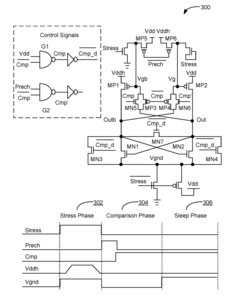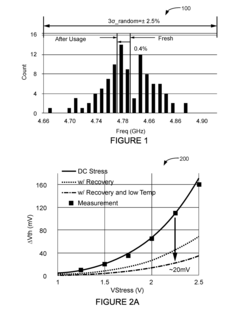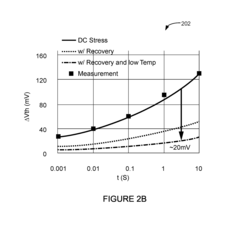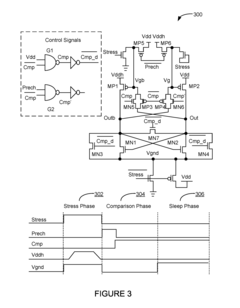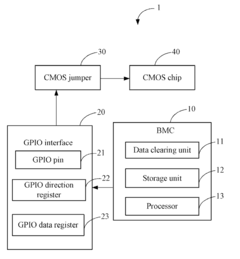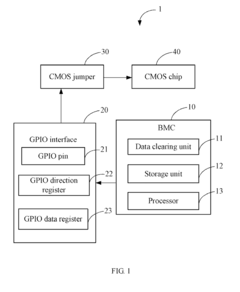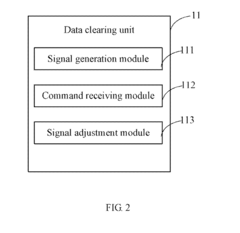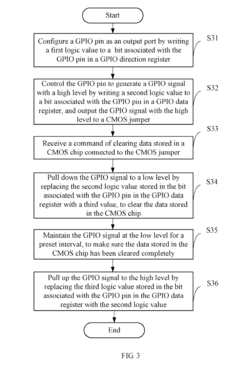How CMOS Battery Revolutionizes Personal Computing Efficiency?
JUL 22, 20259 MIN READ
Generate Your Research Report Instantly with AI Agent
Patsnap Eureka helps you evaluate technical feasibility & market potential.
CMOS Battery Evolution
The evolution of CMOS battery technology in personal computing has been a crucial factor in enhancing system efficiency and reliability. Initially introduced in the 1980s, CMOS (Complementary Metal-Oxide-Semiconductor) batteries were designed to power the real-time clock (RTC) and maintain BIOS settings when the main power was disconnected.
In the early stages, CMOS batteries were typically large, non-rechargeable lithium cells with a lifespan of 3-5 years. These batteries were often soldered directly onto motherboards, making replacement a challenging task for users. As personal computing advanced, the demand for more compact and efficient power solutions grew.
The 1990s saw a shift towards smaller, more easily replaceable CMOS batteries. Coin cell batteries, particularly the CR2032 model, became the industry standard. This transition allowed for easier maintenance and reduced the risk of data loss due to battery failure. Manufacturers also began implementing low-power CMOS chips, extending battery life and improving overall system stability.
With the advent of laptops and mobile computing in the late 1990s and early 2000s, CMOS battery technology faced new challenges. The need for even more compact and energy-efficient solutions led to the development of integrated CMOS power management systems. These systems often utilized the main battery to trickle-charge a small capacitor or secondary battery, eliminating the need for a separate CMOS battery in many mobile devices.
Recent years have seen further advancements in CMOS battery technology. Modern systems often incorporate super capacitors or rechargeable lithium-ion batteries for CMOS backup. These solutions offer longer lifespans and improved reliability compared to traditional coin cell batteries. Additionally, some manufacturers have implemented non-volatile memory technologies to store BIOS settings, reducing reliance on constant power supply.
The latest trend in CMOS power management involves the integration of advanced power-saving features directly into the chipset and BIOS. This approach minimizes power consumption during standby modes and extends the life of backup power sources. Some systems now employ intelligent power management algorithms that can predict and optimize CMOS power usage based on user behavior and system requirements.
Looking forward, the evolution of CMOS battery technology is likely to continue focusing on increased efficiency, longer lifespan, and seamless integration with other system components. As personal computing devices become more diverse and energy-conscious, CMOS power solutions will need to adapt to meet the demands of emerging form factors and use cases, further revolutionizing personal computing efficiency.
In the early stages, CMOS batteries were typically large, non-rechargeable lithium cells with a lifespan of 3-5 years. These batteries were often soldered directly onto motherboards, making replacement a challenging task for users. As personal computing advanced, the demand for more compact and efficient power solutions grew.
The 1990s saw a shift towards smaller, more easily replaceable CMOS batteries. Coin cell batteries, particularly the CR2032 model, became the industry standard. This transition allowed for easier maintenance and reduced the risk of data loss due to battery failure. Manufacturers also began implementing low-power CMOS chips, extending battery life and improving overall system stability.
With the advent of laptops and mobile computing in the late 1990s and early 2000s, CMOS battery technology faced new challenges. The need for even more compact and energy-efficient solutions led to the development of integrated CMOS power management systems. These systems often utilized the main battery to trickle-charge a small capacitor or secondary battery, eliminating the need for a separate CMOS battery in many mobile devices.
Recent years have seen further advancements in CMOS battery technology. Modern systems often incorporate super capacitors or rechargeable lithium-ion batteries for CMOS backup. These solutions offer longer lifespans and improved reliability compared to traditional coin cell batteries. Additionally, some manufacturers have implemented non-volatile memory technologies to store BIOS settings, reducing reliance on constant power supply.
The latest trend in CMOS power management involves the integration of advanced power-saving features directly into the chipset and BIOS. This approach minimizes power consumption during standby modes and extends the life of backup power sources. Some systems now employ intelligent power management algorithms that can predict and optimize CMOS power usage based on user behavior and system requirements.
Looking forward, the evolution of CMOS battery technology is likely to continue focusing on increased efficiency, longer lifespan, and seamless integration with other system components. As personal computing devices become more diverse and energy-conscious, CMOS power solutions will need to adapt to meet the demands of emerging form factors and use cases, further revolutionizing personal computing efficiency.
Market Demand Analysis
The market demand for CMOS battery technology in personal computing has been steadily growing, driven by the increasing need for efficient and reliable power management solutions. As personal computers become more integral to daily life and work, users are seeking devices that offer longer battery life, faster boot times, and improved overall performance. CMOS batteries play a crucial role in maintaining system settings and timekeeping functions, even when the main power source is disconnected.
The personal computing market has witnessed a shift towards more mobile and energy-efficient devices, including laptops, tablets, and hybrid devices. This trend has amplified the importance of CMOS batteries in ensuring seamless user experiences and maintaining system integrity. The global laptop market, which heavily relies on CMOS battery technology, is projected to reach significant growth in the coming years, indicating a strong demand for advanced power management solutions.
In the enterprise sector, the rise of remote work and the need for always-on connectivity have further emphasized the importance of reliable CMOS battery technology. Businesses are increasingly investing in devices that can maintain critical system information and settings, even during prolonged periods of inactivity or power loss. This has led to a growing demand for CMOS batteries with extended lifespan and improved performance characteristics.
The Internet of Things (IoT) and edge computing trends are also contributing to the increased market demand for CMOS battery technology. As more devices become interconnected and require constant uptime, the role of CMOS batteries in maintaining system stability and preserving critical data becomes even more crucial. This expanding ecosystem of connected devices is creating new opportunities for CMOS battery applications beyond traditional personal computing.
Furthermore, the growing emphasis on energy efficiency and environmental sustainability is driving innovation in CMOS battery technology. Consumers and businesses alike are seeking computing solutions that minimize power consumption and reduce electronic waste. This has led to a demand for CMOS batteries with longer lifespans, improved energy density, and more environmentally friendly materials.
The automotive industry's shift towards electric and autonomous vehicles is also creating new market opportunities for CMOS battery technology. These advanced vehicles rely heavily on sophisticated computing systems that require stable power management solutions, including CMOS batteries, to maintain critical settings and ensure reliable operation.
As personal computing continues to evolve, the market demand for CMOS battery technology is expected to grow further. Manufacturers are likely to focus on developing more efficient, longer-lasting, and environmentally friendly CMOS batteries to meet the increasing demands of consumers and businesses alike. This ongoing innovation in CMOS battery technology will play a crucial role in revolutionizing personal computing efficiency and shaping the future of mobile and connected devices.
The personal computing market has witnessed a shift towards more mobile and energy-efficient devices, including laptops, tablets, and hybrid devices. This trend has amplified the importance of CMOS batteries in ensuring seamless user experiences and maintaining system integrity. The global laptop market, which heavily relies on CMOS battery technology, is projected to reach significant growth in the coming years, indicating a strong demand for advanced power management solutions.
In the enterprise sector, the rise of remote work and the need for always-on connectivity have further emphasized the importance of reliable CMOS battery technology. Businesses are increasingly investing in devices that can maintain critical system information and settings, even during prolonged periods of inactivity or power loss. This has led to a growing demand for CMOS batteries with extended lifespan and improved performance characteristics.
The Internet of Things (IoT) and edge computing trends are also contributing to the increased market demand for CMOS battery technology. As more devices become interconnected and require constant uptime, the role of CMOS batteries in maintaining system stability and preserving critical data becomes even more crucial. This expanding ecosystem of connected devices is creating new opportunities for CMOS battery applications beyond traditional personal computing.
Furthermore, the growing emphasis on energy efficiency and environmental sustainability is driving innovation in CMOS battery technology. Consumers and businesses alike are seeking computing solutions that minimize power consumption and reduce electronic waste. This has led to a demand for CMOS batteries with longer lifespans, improved energy density, and more environmentally friendly materials.
The automotive industry's shift towards electric and autonomous vehicles is also creating new market opportunities for CMOS battery technology. These advanced vehicles rely heavily on sophisticated computing systems that require stable power management solutions, including CMOS batteries, to maintain critical settings and ensure reliable operation.
As personal computing continues to evolve, the market demand for CMOS battery technology is expected to grow further. Manufacturers are likely to focus on developing more efficient, longer-lasting, and environmentally friendly CMOS batteries to meet the increasing demands of consumers and businesses alike. This ongoing innovation in CMOS battery technology will play a crucial role in revolutionizing personal computing efficiency and shaping the future of mobile and connected devices.
Technical Challenges
The CMOS battery, a critical component in personal computing, faces several technical challenges that impact its efficiency and longevity. One of the primary issues is the limited energy density of current battery technologies. Despite advancements in lithium-ion batteries, the CMOS battery still relies on older, less efficient chemistries, which restrict its capacity and lifespan. This limitation necessitates more frequent replacements, potentially disrupting system operations and increasing maintenance costs.
Another significant challenge lies in the power consumption of modern computing systems. As personal computers become more sophisticated, with increasingly complex BIOS and UEFI firmware, the demand for constant power to maintain system settings and real-time clock functions grows. This increased power draw puts additional strain on the CMOS battery, potentially shortening its effective lifespan and reliability.
The miniaturization trend in personal computing devices presents another hurdle for CMOS battery technology. As laptops, tablets, and other portable devices become thinner and lighter, the physical space available for the CMOS battery diminishes. This constraint limits the battery's size and, consequently, its capacity, creating a trade-off between device form factor and battery performance.
Temperature sensitivity is an additional technical challenge facing CMOS batteries. These batteries are often exposed to varying temperatures within computer systems, which can fluctuate significantly during operation. Extreme temperatures, both hot and cold, can adversely affect the battery's performance, reducing its capacity and accelerating degradation. This sensitivity necessitates careful thermal management within the device to maintain optimal battery function.
The environmental impact of CMOS batteries also poses a technical challenge. Many of these batteries contain hazardous materials, such as lithium or mercury, which require special handling and disposal procedures. Developing more environmentally friendly alternatives that maintain the necessary performance characteristics remains a significant hurdle for manufacturers and researchers in the field.
Compatibility issues across different computer models and manufacturers present another technical obstacle. The lack of standardization in CMOS battery form factors and electrical specifications can lead to difficulties in replacement and interoperability. This diversity complicates the development of universal solutions and may result in increased costs and complexity for both manufacturers and consumers.
Lastly, the integration of CMOS battery functionality with other power management systems in personal computers presents ongoing challenges. As devices become more energy-efficient and incorporate advanced power-saving features, coordinating the CMOS battery's role within these complex systems requires sophisticated engineering solutions. Balancing the need for constant power to critical system components with overall energy efficiency goals remains a significant technical hurdle in personal computing design.
Another significant challenge lies in the power consumption of modern computing systems. As personal computers become more sophisticated, with increasingly complex BIOS and UEFI firmware, the demand for constant power to maintain system settings and real-time clock functions grows. This increased power draw puts additional strain on the CMOS battery, potentially shortening its effective lifespan and reliability.
The miniaturization trend in personal computing devices presents another hurdle for CMOS battery technology. As laptops, tablets, and other portable devices become thinner and lighter, the physical space available for the CMOS battery diminishes. This constraint limits the battery's size and, consequently, its capacity, creating a trade-off between device form factor and battery performance.
Temperature sensitivity is an additional technical challenge facing CMOS batteries. These batteries are often exposed to varying temperatures within computer systems, which can fluctuate significantly during operation. Extreme temperatures, both hot and cold, can adversely affect the battery's performance, reducing its capacity and accelerating degradation. This sensitivity necessitates careful thermal management within the device to maintain optimal battery function.
The environmental impact of CMOS batteries also poses a technical challenge. Many of these batteries contain hazardous materials, such as lithium or mercury, which require special handling and disposal procedures. Developing more environmentally friendly alternatives that maintain the necessary performance characteristics remains a significant hurdle for manufacturers and researchers in the field.
Compatibility issues across different computer models and manufacturers present another technical obstacle. The lack of standardization in CMOS battery form factors and electrical specifications can lead to difficulties in replacement and interoperability. This diversity complicates the development of universal solutions and may result in increased costs and complexity for both manufacturers and consumers.
Lastly, the integration of CMOS battery functionality with other power management systems in personal computers presents ongoing challenges. As devices become more energy-efficient and incorporate advanced power-saving features, coordinating the CMOS battery's role within these complex systems requires sophisticated engineering solutions. Balancing the need for constant power to critical system components with overall energy efficiency goals remains a significant technical hurdle in personal computing design.
Current CMOS Solutions
01 Power management techniques for CMOS batteries
Various power management techniques are employed to enhance CMOS battery efficiency. These include implementing low-power modes, optimizing voltage regulation, and utilizing power-saving circuits. Such techniques help extend battery life and improve overall system performance in CMOS-based devices.- Power management techniques for CMOS batteries: Various power management techniques are employed to enhance CMOS battery efficiency. These include implementing low-power modes, optimizing voltage regulation, and utilizing power-saving circuits. Such techniques help extend battery life and improve overall system performance in CMOS-based devices.
- CMOS battery monitoring and replacement systems: Advanced monitoring systems are developed to track CMOS battery health and performance. These systems can provide real-time data on battery status, predict potential failures, and facilitate timely replacements. This proactive approach ensures continuous operation of CMOS-dependent components and prevents data loss due to battery failure.
- Integration of energy-efficient components with CMOS batteries: Incorporating energy-efficient components alongside CMOS batteries can significantly improve overall system efficiency. This includes using low-power memory modules, optimized clock generators, and energy-saving peripheral devices. Such integration reduces the load on the CMOS battery, extending its lifespan and improving reliability.
- CMOS battery charging and energy harvesting techniques: Innovative charging methods and energy harvesting techniques are developed to maintain CMOS battery efficiency. These may include trickle charging systems, solar-powered charging, or harvesting energy from system heat or vibrations. Such approaches help maintain battery charge levels and reduce the frequency of replacements.
- CMOS circuit design optimization for battery efficiency: Optimizing CMOS circuit designs can lead to improved battery efficiency. This involves techniques such as reducing leakage current, implementing dynamic voltage scaling, and utilizing sleep modes for inactive components. These design optimizations minimize power consumption and extend CMOS battery life.
02 CMOS battery monitoring and replacement systems
Advanced monitoring systems are developed to track CMOS battery health and performance. These systems can provide real-time data on battery status, predict potential failures, and facilitate timely replacements. This proactive approach ensures continuous operation of CMOS-dependent components and prevents data loss due to battery failure.Expand Specific Solutions03 Energy harvesting for CMOS battery supplementation
Innovative energy harvesting techniques are integrated into CMOS systems to supplement or recharge the battery. These methods may include harvesting energy from ambient light, thermal gradients, or mechanical vibrations, reducing the load on the primary CMOS battery and extending its operational lifespan.Expand Specific Solutions04 CMOS circuit design optimization for battery efficiency
Advanced circuit design techniques are employed to optimize CMOS systems for improved battery efficiency. These include implementing dynamic voltage and frequency scaling, utilizing sleep transistors, and designing low-leakage memory cells. Such optimizations significantly reduce power consumption and extend battery life in CMOS devices.Expand Specific Solutions05 Integration of alternative power sources with CMOS batteries
Research focuses on integrating alternative power sources alongside traditional CMOS batteries. This may include the use of supercapacitors, fuel cells, or other emerging energy storage technologies. The combination of multiple power sources can lead to improved efficiency, longer operational times, and enhanced reliability in CMOS-based systems.Expand Specific Solutions
Key Industry Players
The CMOS battery market is in a mature stage, with a steady global market size driven by the ubiquity of personal computing devices. The technology's maturity is evident in its widespread adoption across various computing platforms. Key players like Hon Hai Precision Industry, IBM, and Dell Products LP have established strong positions in this sector, leveraging their expertise in computer hardware manufacturing. Companies such as Intel and Samsung Electronics contribute to the ecosystem through their semiconductor capabilities. While the core technology is well-established, ongoing innovations focus on improving battery life, miniaturization, and integration with advanced computing systems, ensuring the continued relevance of CMOS batteries in modern personal computing.
International Business Machines Corp.
Technical Solution: IBM has developed advanced CMOS battery technology for personal computing, focusing on power efficiency and longevity. Their approach includes implementing smart power management systems that optimize battery usage based on user behavior and workload patterns[1]. IBM's CMOS batteries feature enhanced energy density and reduced self-discharge rates, allowing for longer intervals between replacements. Additionally, they have integrated machine learning algorithms to predict battery life and performance, enabling proactive maintenance and replacement scheduling[3].
Strengths: Advanced power management, predictive maintenance, and high energy density. Weaknesses: Potentially higher cost due to advanced features, may require specialized knowledge for maintenance.
Samsung Electronics Co., Ltd.
Technical Solution: Samsung has made significant strides in CMOS battery technology for personal computing. Their approach focuses on high-capacity, long-lasting batteries with improved thermal management. Samsung's CMOS batteries utilize advanced materials that enhance energy density while maintaining a compact form factor. They have also implemented smart charging algorithms that optimize charging cycles to extend overall battery lifespan[5]. Additionally, Samsung has developed batteries with improved resistance to capacity degradation, ensuring consistent performance over time[6].
Strengths: High energy density, improved thermal management, and long-term durability. Weaknesses: Potential for higher manufacturing costs, may require specific charging hardware for optimal performance.
Core CMOS Innovations
System and method for integrated circuit usage tracking circuit with fast tracking time for hardware security and re-configurability
PatentActiveUS20160329897A1
Innovation
- A silicon marker technique using conventional CMOS devices with an accelerated aging circuit and stochastic processing methodology to create a reliable usage marker within seconds, leveraging NBTI effects and latch-based comparator circuits to enhance detection accuracy and tolerance to process variations.
Computing device and method for clearing data stored in complementary metal-oxide semiconductor chip
PatentInactiveUS20120047307A1
Innovation
- A computing device with a data clearing unit that uses a GPIO interface to configure a CMOS jumper, generating a high-level signal to maintain data and then pulling it down to clear data stored in the CMOS chip, allowing for safe and controlled data reset.
Power Management
Power management is a critical aspect of personal computing efficiency, and the CMOS battery plays a pivotal role in this domain. The Complementary Metal-Oxide-Semiconductor (CMOS) battery, also known as the Real-Time Clock (RTC) battery, has revolutionized power management in personal computers by providing a constant, low-power source of electricity to maintain essential system settings and timekeeping functions.
One of the primary functions of the CMOS battery is to preserve BIOS settings when the computer is powered off. This includes crucial information such as hardware configurations, boot sequences, and system time. By maintaining these settings, the CMOS battery ensures that the computer can start up quickly and efficiently without requiring reconfiguration each time it is turned on.
The CMOS battery's ability to keep the system clock running even when the computer is unplugged or powered down is another significant contribution to power management. This feature allows for accurate timekeeping, which is essential for various system processes, scheduled tasks, and time-sensitive applications. The precision in timekeeping facilitated by the CMOS battery helps optimize power consumption by enabling more accurate sleep and wake cycles for both the system and individual components.
Furthermore, the CMOS battery supports advanced power management features such as Wake-on-LAN and scheduled power-on/off functions. These capabilities allow systems to remain in low-power states for extended periods while still being able to respond to network events or power up at predetermined times. This functionality contributes to overall energy efficiency by minimizing unnecessary power consumption during periods of inactivity.
The longevity and reliability of modern CMOS batteries have also contributed to improved power management. With a typical lifespan of 2-10 years, depending on usage and environmental factors, these batteries provide consistent support for power management functions over extended periods. This reliability reduces the need for frequent battery replacements, minimizing system downtime and maintenance requirements.
In recent years, advancements in CMOS battery technology have led to the development of more energy-efficient and environmentally friendly options. Lithium-ion CMOS batteries, for instance, offer higher energy density and longer lifespan compared to traditional coin cell batteries. These improvements not only enhance power management capabilities but also align with the growing emphasis on sustainable computing practices.
The integration of CMOS batteries with modern power management protocols, such as Advanced Configuration and Power Interface (ACPI), has further enhanced personal computing efficiency. This integration allows for more sophisticated power states and transitions, enabling finer control over system resources and energy consumption. As a result, personal computers can achieve optimal performance while minimizing power usage, leading to improved battery life in portable devices and reduced energy costs for desktop systems.
One of the primary functions of the CMOS battery is to preserve BIOS settings when the computer is powered off. This includes crucial information such as hardware configurations, boot sequences, and system time. By maintaining these settings, the CMOS battery ensures that the computer can start up quickly and efficiently without requiring reconfiguration each time it is turned on.
The CMOS battery's ability to keep the system clock running even when the computer is unplugged or powered down is another significant contribution to power management. This feature allows for accurate timekeeping, which is essential for various system processes, scheduled tasks, and time-sensitive applications. The precision in timekeeping facilitated by the CMOS battery helps optimize power consumption by enabling more accurate sleep and wake cycles for both the system and individual components.
Furthermore, the CMOS battery supports advanced power management features such as Wake-on-LAN and scheduled power-on/off functions. These capabilities allow systems to remain in low-power states for extended periods while still being able to respond to network events or power up at predetermined times. This functionality contributes to overall energy efficiency by minimizing unnecessary power consumption during periods of inactivity.
The longevity and reliability of modern CMOS batteries have also contributed to improved power management. With a typical lifespan of 2-10 years, depending on usage and environmental factors, these batteries provide consistent support for power management functions over extended periods. This reliability reduces the need for frequent battery replacements, minimizing system downtime and maintenance requirements.
In recent years, advancements in CMOS battery technology have led to the development of more energy-efficient and environmentally friendly options. Lithium-ion CMOS batteries, for instance, offer higher energy density and longer lifespan compared to traditional coin cell batteries. These improvements not only enhance power management capabilities but also align with the growing emphasis on sustainable computing practices.
The integration of CMOS batteries with modern power management protocols, such as Advanced Configuration and Power Interface (ACPI), has further enhanced personal computing efficiency. This integration allows for more sophisticated power states and transitions, enabling finer control over system resources and energy consumption. As a result, personal computers can achieve optimal performance while minimizing power usage, leading to improved battery life in portable devices and reduced energy costs for desktop systems.
Environmental Impact
The environmental impact of CMOS batteries in personal computing is a crucial aspect to consider as these components become increasingly prevalent. While CMOS batteries contribute to improved efficiency and performance in personal computers, their production, use, and disposal have both positive and negative environmental implications.
On the positive side, CMOS batteries significantly extend the lifespan of personal computers by maintaining system settings and time information. This longevity reduces the frequency of hardware replacements, thereby decreasing electronic waste generation. Additionally, the improved energy efficiency of systems utilizing CMOS batteries leads to reduced power consumption over the device's lifetime, contributing to lower overall energy demand and associated carbon emissions.
However, the manufacturing process of CMOS batteries involves the use of various materials, including lithium, which can have environmental consequences during extraction and processing. The mining of lithium, in particular, can lead to water pollution, soil degradation, and ecosystem disruption in the areas where it is sourced. Furthermore, the production of CMOS batteries requires energy-intensive processes, contributing to greenhouse gas emissions.
The disposal of CMOS batteries at the end of their lifecycle presents another environmental challenge. These batteries contain potentially harmful materials that can leach into soil and water systems if not properly managed. Improper disposal can lead to contamination of landfills and pose risks to wildlife and human health. To mitigate these issues, it is crucial to implement and promote effective recycling programs for CMOS batteries and other electronic components.
Despite these challenges, advancements in CMOS battery technology are driving improvements in their environmental profile. Manufacturers are exploring more sustainable materials and production methods to reduce the environmental footprint of these components. For instance, research into alternative materials for lithium and more energy-efficient manufacturing processes shows promise in minimizing the negative environmental impacts associated with CMOS battery production.
Moreover, the increased efficiency and reliability provided by CMOS batteries in personal computing systems contribute to reduced energy consumption and extended device lifespans. This efficiency translates to lower overall environmental impact throughout the lifecycle of personal computers, potentially offsetting some of the negative effects associated with their production and disposal.
In conclusion, while CMOS batteries play a vital role in revolutionizing personal computing efficiency, their environmental impact is complex and multifaceted. Balancing the benefits of improved performance and longevity against the challenges of production and disposal requires ongoing research, innovation, and responsible management practices across the industry.
On the positive side, CMOS batteries significantly extend the lifespan of personal computers by maintaining system settings and time information. This longevity reduces the frequency of hardware replacements, thereby decreasing electronic waste generation. Additionally, the improved energy efficiency of systems utilizing CMOS batteries leads to reduced power consumption over the device's lifetime, contributing to lower overall energy demand and associated carbon emissions.
However, the manufacturing process of CMOS batteries involves the use of various materials, including lithium, which can have environmental consequences during extraction and processing. The mining of lithium, in particular, can lead to water pollution, soil degradation, and ecosystem disruption in the areas where it is sourced. Furthermore, the production of CMOS batteries requires energy-intensive processes, contributing to greenhouse gas emissions.
The disposal of CMOS batteries at the end of their lifecycle presents another environmental challenge. These batteries contain potentially harmful materials that can leach into soil and water systems if not properly managed. Improper disposal can lead to contamination of landfills and pose risks to wildlife and human health. To mitigate these issues, it is crucial to implement and promote effective recycling programs for CMOS batteries and other electronic components.
Despite these challenges, advancements in CMOS battery technology are driving improvements in their environmental profile. Manufacturers are exploring more sustainable materials and production methods to reduce the environmental footprint of these components. For instance, research into alternative materials for lithium and more energy-efficient manufacturing processes shows promise in minimizing the negative environmental impacts associated with CMOS battery production.
Moreover, the increased efficiency and reliability provided by CMOS batteries in personal computing systems contribute to reduced energy consumption and extended device lifespans. This efficiency translates to lower overall environmental impact throughout the lifecycle of personal computers, potentially offsetting some of the negative effects associated with their production and disposal.
In conclusion, while CMOS batteries play a vital role in revolutionizing personal computing efficiency, their environmental impact is complex and multifaceted. Balancing the benefits of improved performance and longevity against the challenges of production and disposal requires ongoing research, innovation, and responsible management practices across the industry.
Unlock deeper insights with Patsnap Eureka Quick Research — get a full tech report to explore trends and direct your research. Try now!
Generate Your Research Report Instantly with AI Agent
Supercharge your innovation with Patsnap Eureka AI Agent Platform!
